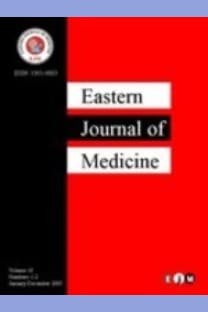The First Three Years of Ablation Therapy in Cardiac Arrhythmias: Single Centre Experience
___
1. Intracardiac electrograms and sensing test signals: electrophysiological, physical, and technical considerations. Irnich W. Pacing Clin Electrophysiol 1985; 8: 870-888.2. A novel method for nonfluoroscopic catheterbased electroanatomical mapping of the heart. In vitro and in vivo accuracy results. Gepstein L, Hayam G, Ben-Haim SA. Circulation 1997; 95: 1611-1622.
3. Recent advances in cardiac mapping system. Schmitt C, Ndrepepa G, Deisenhofer I, Schneider M. Curr Cardiol Resp 1999; 1: 149- 156.
4. On the use of CartoSound for left atrial navigation. Schwartzman D, Zhong H. J Cardiovasc Electrophysiol 2010; 21: 656-664.
5. Prospective randomized comparison of antiarrhythmic therapy versus first-line radiofrequency ablation in patients with atrial flutter. Natale A, Newby KH, Pisano E, Leonelli F, Fanelli R, Potenza D, Beheiry S, Tomassoni G. J Am Coll Cardiol 2000; 35: 1898-1904.
6. Wazni OM, Marrouche NF, Martin DO, et al. Radiofrequency ablation vs antiarrhythmic drugs as first line treatment of symptomatic atrial fibrillation: a randomized trial. JAMA 2005; 293: 2634-2640.
7. Martirosyan M, Kiss A, Nagy-Balo E, et al. Learning curve in circular multipolar phased radifrequency ablation of atrial fibrillation. Cardiol J 2015; 22: 260-266.
8. Jastrzebski M, Moskal P, Pitak M, et al. Contemporary outcomes of catheter ablation of accessory pathways: complications and learning curve. Kardiol Pol 2017; 75: 804-810.
9. Holmqvist F, Kesek M, Englund A, et al. A decade of catheter ablation of cardiac arrhythmias in Sweden: ablation practices and outcomes. Eur Heart J 2019; 40: 820-830.
10. Skanes AC, Dubuc M, Klein GJ, et al. Cryothermal ablation of the slow pathway for the elimination of atrioventricular nodal reentrant tachycardia. Circulation 2000; 102: 2856-2860.
11. Khairy P, Novak PG, Guerra PG, et al. Cryothermal slow pathway modification for atrioventricular nodal reentrant tachycardia. Europace 2007; 9: 909-914.
12. Bastani H, Schwieler J, Insulander P, et al. Acute and long-term outcome of cryoablation therapy of typical atrioventricular nodal reentrant tachycardia. Europace 2009; 11: 1077-1082.
13. Friedman PL, Dubuc M, Green MS, et al. Catheter cryoablation of supraventricular tachycardia: results of the multicenter prospective ―frosty‖ trial. Heart Rhythm 2004; 1: 129-138.
14. Estner HL, Ndrepepa G, Dong J, et al. Acute and long-term results of slow pathway ablation in patients with atrioventricular nodal reentrant tachycardia—an analysis of the predictive factors for arrhythmia recurrence. Pacing Clin Electrophysiol 2005; 28: 102-110.
15. Clague JR, Dagres N, Kottkamp H, Breithardt G, Borggrefe M. Targeting the slow pathway for atrioventricular nodal reentrant tachycardia: initial results and long-term follow-up in 379 consecutive patients. Eur Heart J 2001; 22: 82-88.
16. Insulander P, Bastani H, Braunschweig F, et al. Cryoablation of substrates adjacent to the atrioventricular node: acute and long-term safety of 1303 ablation procedures. Europace 2014; 16: 271-276.
17. Sharma AD, Klein GJ, Guiraudon GM, Milstein S. Atrial fibrillation in patients with Wolff–Parkinson–White syndrome: incidence after surgical ablation of the accessory pathway. Circulation 1985; 72: 161-169.
18. Campbell RW, Smith RA, Gallagher JJ, Pritchett EL, Wallace AG. Atrial fibrillation in the preexcitation syndrome. Am J Cardiol 1977; 40: 514-520.
19. Yamane T, Jaïs P, Shah DC, et al. Efficacy and safety of an irrigated-tip catheter for the ablation of accessory pathways resistant to conventional radiofrequency ablation. Circulation 2000; 102: 2565-2568.
20. Martins RP, Nicolas A, Galand V, et al. The challenging right inferior pulmonary vein: A systemic approach for successful cryballoon ablation. Arch Cardiovasc Dis 2019; 112: 502- 511.
- ISSN: 1301-0883
- Yayın Aralığı: 4
- Başlangıç: 1996
- Yayıncı: ERBİL KARAMAN
Hereditary Thrombophilia Risk Factors In Patients With Venous Thromboembolism
Sabahattin DESTEK, Vahit Onur GÜL
Adult Patient Cancer Statistics of Mardin Province
Evaluation of depression in patients with bone metastasis before and after radiotherapy
Feryal KARACA, Selahattin MENTEŞ, Çiğdem Usul AFŞAR, Yaşar SERTDEMİR, Timuçin ÇİL
Ömer Faruk KOÇAK, Veli AVCİ, Kemal AYENGİN
Serap KESKİN TUNÇ, Nazli Zeynep Alpaslan YAYLİ, Ahmet Cemil TALMAÇ, Erkan FESLİHAN, Volkan KAPLAN
Relationship Between Peripheral Perfusion Index and Anxiety
Ahmet Yusuf YÜKSEK, Cevdet YARDİMCİ
Assessment of Maternal and Fetal Outcomes in Adolescent and Non-Adolescent Pregnant Women
Elçin BALCI, Zehra İncedal SONKAYA, Şemsinnur GÖÇER
Relationship Between Biomass Exposure, Chronic Headache and Brain Damage in Young Women
Ayse ARSLAN, Fatma Aykan TÜZÜN, Harun ARSLAN
Ali Kemal GÜR, Şahin ŞAHİNALP, Harun UNAL
Can We Estimate the Recurrence of Primary Spontaneous Pneumothorax With Simple Blood Tests?
